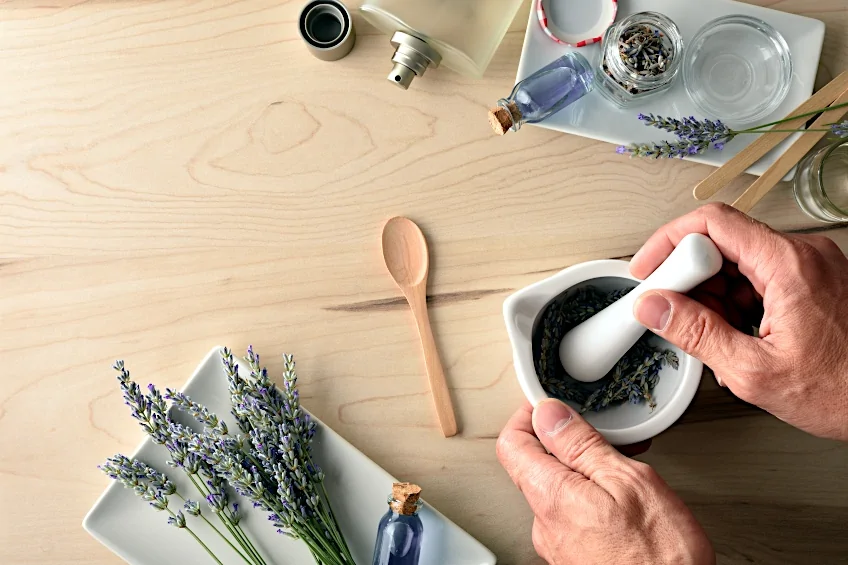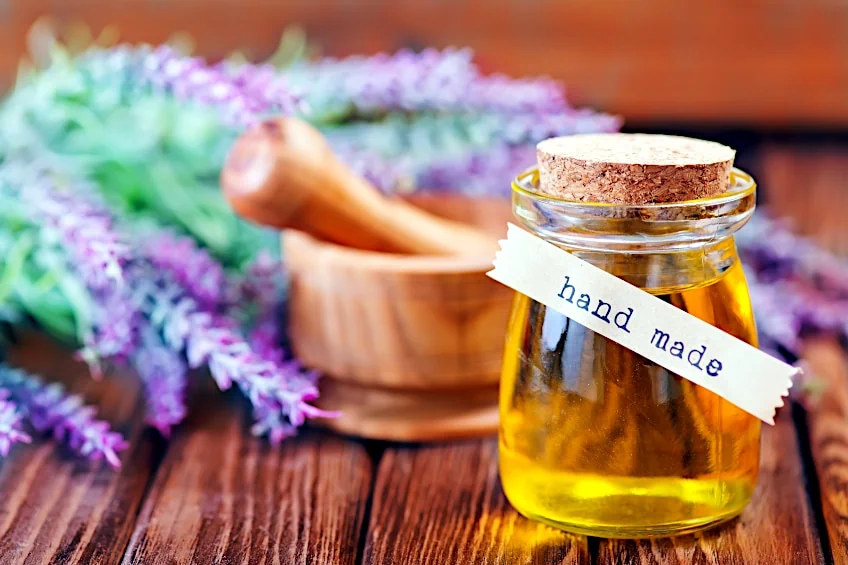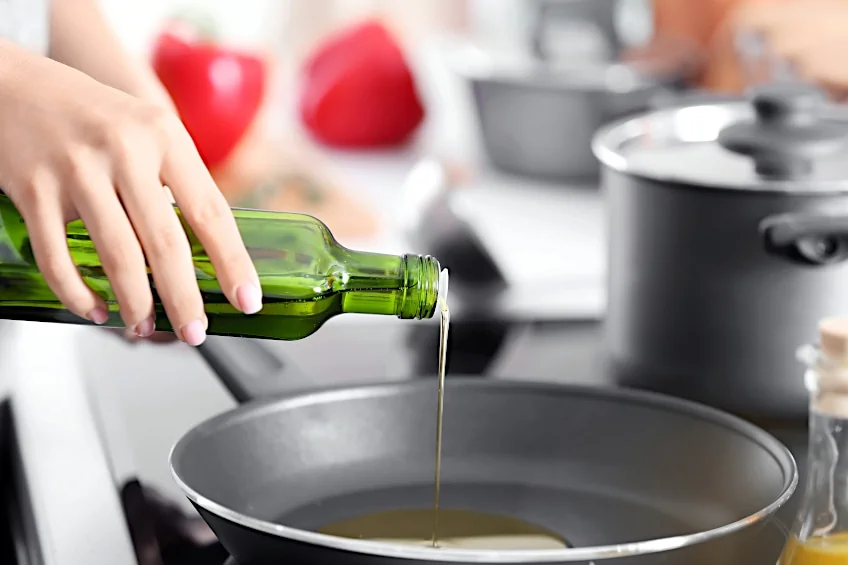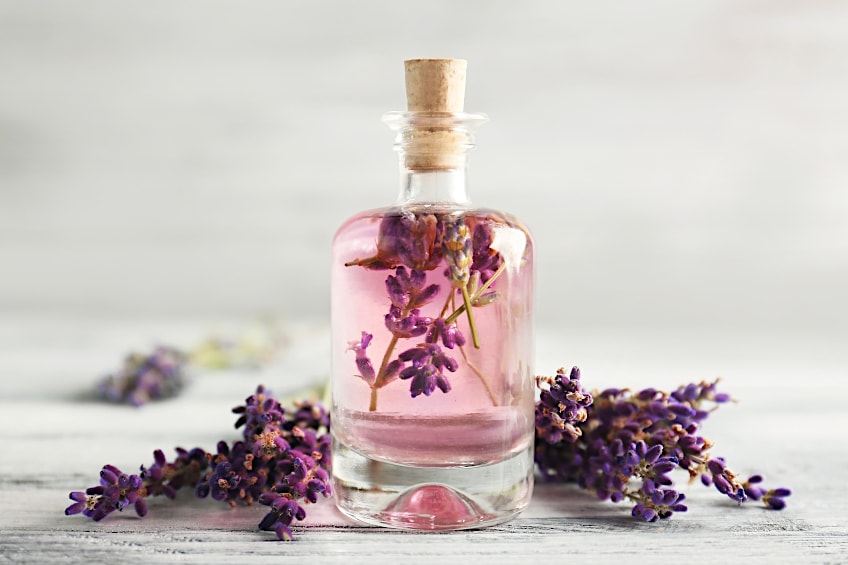Lavender is one of the better-known plants that is grown in our backyards. There are quite a few people who have wondered how to make lavender essential oil, which has various uses. In this article, we will quickly learn how to make lavender essential oil. We will also discover other uses of homegrown lavender.
What Is Lavender Essential Oil?
Lavender essential oil is one of the more popular and better-known essential oils in aromatherapy. The use of lavender essential oil has been around for many years. It is a cluster of the flower’s aromatic oils. Refined from the mother plant, Lavandula angustifolia, the oil is believed to assist with anxiety, relaxation, skin conditions such as eczema, allergies, and many more health benefits.
It is generally made by gathering lavender flowers and extracting its oils using a steam purification method.

What Is the Difference Between Essential Lavender Oil and Infused Lavender Oil?
Infused lavender oil is quite simply a fragrant oil. It does not always come directly from the plant like lavender essential oil does. Both essential lavender oils and infused lavender oils are fragrant by use of the scents of different plants. Essential oils are extracted directly from the plant, which makes them more concentrated and therefore, also more expensive.
Infused oils are made by the softening of fresh or dried-out lavender flowers and soaks in the carrier oil over a period of several weeks.
What Is Lavender?
The name ‘lavender’ originates from the Latin word lavare meaning “to wash”. It is believed to derive from the Mediterranean, Middle East, and India. This flowering plant from the mint family is known for its beauty, sweet floral scent, and many other uses.

As we know, lavender (lavandula) is purple in appearance. Although most commonly found in our herb gardens for culinary use, the aromatic scent is associated with cleanliness. Lavender also has lots of healthy beneficial qualities.

Benefits of Lavender Essential Oil
Lavender essential oil has many health benefits, namely; stress, depression and anxiety relief, skincare, soothes and helps heal insect bites, sunburn as well as minor cuts, burns, and even inflammatory conditions. Lavender essential oil could also be consumed orally to treat internal medical conditions, it is also often used to aid sleep.
Below are some of the benefits of using lavender essential oil.

Healing Property Benefits
Lavender essential oil and lavender infused oil is believed to have antiseptic, as well as anti-inflammatory properties. It also assists with treating headaches by massaging some of the oil onto the temples. It can soothe sunburn and aid in healing minor cuts. It has also been used for muscle and joint pain.

Stress and Anxiety Relief Benefits
The lavender flower is known to be uplifting and soothing, that being said, lavender has a sedative effect that may help calm the nerves. The sedative effect could also help with sleep troubles. Massaging the essential oil into the skin, or using some of it in your bath could help reduce anxiety.
A cheat code for using lavender around the house is by diffusing it.
Skincare Benefits
Your DIY (do it yourself) lavender essential oil has quite a few benefits for your skin. For one, it gently moisturizes and is non-comedogenic for pores. It is naturally antibacterial; this means that it eliminates acne-causing bacteria. Not only is it perfect for treating acne, but it also helps to soothe dry skin conditions like eczema. That is the way to draw mountains in a few easy and simple steps!
The use of lavender essential oil, as well as lavender-infused oils on the skin can help reduce redness, blotchy patches, and acne scarring. Most people may not know this, but lavender essential oils pack loads of antioxidants and other beneficial phytochemicals, which makes them useful to take on premature aging, fine lines, and dark spots.
Lastly, it aids in keeping the skin looking healthy!

Deodorization and Perfume Benefits
As you may know, lavender is especially known for its aromatic properties. The scent is often used in our lotions and creams, and even in household products. Many of us favor the lavender scent as it gives off a fresh and clean smell. Lavender may be used to freshen your linens, closets, and drawers.

Bug Repellent Benefits
As we know, lavender has analgesic, antifungal, and antiseptic properties. So should you get bitten by a pesky mosquito, your homemade lavender oil is your go-to. It will soothe and calm the skin. It is not only useful for mosquito bites but for any insect bite as they do not like the smell.

Hair and Scalp Treatment Benefits
There are certain studies that show using lavender essential oil can promote hair growth. An easy way to use lavender essential oil on your hair is to add some of the oil to your shampoo when you wash your hair. To get the maximum effect out of it, massage your scalp for a minute or longer. Besides promoting hair growth, your DIY lavender oil can also help fight dandruff if this is something you struggle with.
It soothes an itchy scalp and other infections one may have.
Culinary Uses
Since lavender is part of the mint family, it can also be used in the preparation of food. Lavender brings a floral and slightly sweet flavor to the table and therefore is better used in desserts. You could also use it in salads, meat, and seafood dishes.
Although, it is quite potent in scent and flavor, and is recommended that you do not use too much of it.
Which Carrier Oil Should You Use?
Some of the better, or more commonly used carrier oils are coconut oil, olive oil, almond oil, and jojoba oil. There are many other carrier oils that you may make use of when making lavender essential oil as well. It is no surprise that the type of carrier oil you choose will most likely be dependent on the benefits you expect to get from it. Keeping in mind, that to get the best result for beauty applications, cold-pressed oils with no additives or preservatives will work.
However, let us not forget that you do want an overpowering smell from the oil as you want the lavender to pull through.

Different carrier oils could have various effects on the skin, this is depending on your skin type and properties of the oil. If you have sensitive skin, it could be necessary to test a few types of oils before choosing one. Some of the oils could possibly irritate the skin and/or scalp.
Properties of Carrier Oils
It is suggested that you have a look at the benefits and potential disadvantages of each carrier oil before getting one. Most of these carrier oils can be bought at your grocery store or a specialty food store.

Coconut Oil
Coconut oil contains many nutrients and is good for cognitive function, hair and skin health, as well as metabolism. Unrefined coconut oil is also a choice of carrier oils you could choose from, because it is not processed with any chemicals, it is one of the better choices.

Olive Oil
Olive oil is a natural oil extracted from the olive plant. It is a healthy option as it contains omega-6 and omega-3 fatty acids, and also vitamin E. Olive oil has lots of antioxidants and can help fight inflammation.
It will help moisturize your skin by locking in moisture.

Almond Oil
Almond oil is mild and gentle on the skin. Some of you may have sensitive skin or could be prone to flare-ups, this type of oil is perfect to use in that case. Almond oil can help improve your skin tone and complexion, and can also be used to treat dry, flaky skin.

Jojoba Oil
Jojoba oil is what is called a humectant ingredient, which means that it is used to attract water to the top layer of your skin to keep it hydrated. It is also antibacterial and an antioxidant. It consists of vitamins B, C, and E and moisturizes both hair and skin.

How to Make Lavender Essential Oil
When using fresh lavender, cut a bunch of lavender flowers to dry. You should have at least enough to make one ounce of dried lavender. When drying the lavender, tie your bunch of lavender together with a piece of string or elastic and hang it upside down in a dry, dark place for two to four weeks.
Try not to expose the lavender flowers to sunlight during the drying process. Of course, you do have the option to buy lavender flowers or buds dried. When making your lavender essential oil, there are a few things you’ll need:
- One cup of carrier oil (of your choosing)
- Two cups of dried lavender flowers or dried lavender buds (organic is preferable)
- Glass jar with lid
- A piece of muslin or cheesecloth
- A bowl
- Medium saucepan
- Measuring cup

Step-by-Step Instructions on How to Make Lavender Essential Oil
Once you have harvested your lavender, and it has dried out, you can now proceed with preparing the rest of the things you need to make the lavender essential oil. The process of making lavender essential oil is done in a few easy steps.

Step 1
Heat the oil. When making lavender essential oil, use a measuring cup to add the carrier oil to the saucepan and then place it on the stovetop or a burner. Using a medium heat, allow the oil to bubble. Make sure you do not allow moisture to get into the oil during this process, as it could splatter.

Step 2
Add the dried lavender flowers or dried lavender buds to your saucepan with the carrier oil and stir the mixture. Allow the mixture to simmer uncovered for about 30 minutes, monitoring the temperature, making sure it does not get too hot.
The mixture will need to cool to room temperature.

Step 3
After allowing the mixture to cool, pour it into the muslin or cheesecloth over the bowl to strain out the lavender flowers or buds. If you want fewer pieces of lavender in the mixture, you could strain it twice. Use the glass jar to store your oil, preferably in a cool, dark place. Remember to tighten the lid.
It is recommended to test the oil on a small area of skin before applying large amounts of it. Use the inside of your wrist for a patch test. Allow the oil to set on skin for at least one day before checking for any signs of irritation. Should there be any signs of redness or sensitivity, it would be best to avoid using that particular carrier oil for future products.
How to Make Lavender-Infused Oil
The process of making lavender-infused oil is similar to that of the lavender essential oil, except the process is not as lengthy. Making lavender-infused oil or homemade lavender oil can take seven to 10 days. Here is a list of things you might possibly need:
- Lavender buds, flowers (preferably dried already)
- Jar with a tight-fitting lid
- Carrier oil
- Bowl (optional)
- Muslin or cheesecloth
- Sunlight or double boiler or crockpot (optional)

Step-by-Step Instructions on How to Make Lavender-Infused Oil
The process of making lavender-infused oil is all about allowing the lavender to soak in the carrier oil so that the scent can be drawn out of the flower. Here are a few steps to help guide you through the process.

Step 1
Let the lavender dry. If you are using fresh lavender flowers, cut off the stems of lavender along with the flowers, in 6-inch segments or longer. Try to avoid the thick stems at the base, as you will only need the flowers (buds) and leaves to infuse the oil. Let them dry in the shade in a wrapped cloth or bunch them together and hang them upside down.

Any exposure to sunlight will dry it out much faster and could break down the aromatic oils. Fresh cut lavender could take up to two weeks to dry. There is always the option to purchase dried lavender flowers or buds if you do not have the time to do this.
Step 2
Lightly break up the pieces of lavender and place them in the jar. Making sure your hands are clean and dry, crumble up the lavender carefully. If you are using the buds, open them up with your fingers and then put them in the jar. Make sure it is clean.

Step 3
Pour the oil over the lavender flowers. Using the carrier oil, pour it into the jar, fully covering the lavender. Leave about 2-inches of space on the top of the jar in case it expands. Depending on your choice of carrier oil, it is recommended that you smell it first as it can be quite overpowering. Be sure not to mix water into the oil as it could interfere with the infusion.
Step 4
Soak the lavender and, covering the jar tightly, leave the mixture to soak in the sunlight. The mixture may take up to 48 hours to achieve a noticeable lavender scent. Should you not have time or sunlight, you may heat the oil (this part is optional). Heat the mixture in a double boiler or crockpot for about two to five hours, and be sure to keep it at a temperature of between 100 to 120 degrees Fahrenheit (37 to 48 degrees Celsius).
Allow it to simmer for about 30 minutes, monitoring the heat and making sure you do not mix any water in the oil.

Step 5
Strain the oil. Using the muslin or cheesecloth, put it over the bowl (or directly into your jar) and pour the oil and lavender mixture over it. Discard the flowers and any other lavender pieces, you may use them in compost or in your garden.
Step 6
Add a few drops of vitamin E (this is optional). If you do not have a cool, dark place to store the oil, it is recommended that you add some vitamin E to the infusion process as this will help improve the shelf life of your homemade lavender oil.
What Can You Mix Lavender Essential Oil with?
Lavender is one of the easiest scents to use that mixes well with any other scent. As we may know, lavender has a very clean smell. Blending is when you combine two or more scents, or in this case, essential oils. When we combine the scents or oils, we are allowing them to work together to achieve more than the individual impact of each scent on its own.

If you have not experimented with blending before, it is recommended that you start with only two essential oils. Keep in mind that you are trying to establish a good scent from mixing the two, so when we first mix two scents together, we might not actually like it or the new smell could just annoy you. Remember to take it slow when you start out with the blending process.
Blending The Essential Oils
When you start the blending process, you first have to decide on the scent you want. You will have the option to choose between a top, middle, and base note scent. A top note scent effectively evaporates quicker as they are light scents. A base note scent will last longer as it is a deeper scent.

To test a blend, you could make use of a cotton swab. Use the cotton swab to get a sample of each oil you would like to use. Remember to use a fresh one for each oil. Hold the cotton swabs away from your nose, swirling them around in circles to give you an idea of what the combined scent would be. If you do not like the smell, try a different mix.

Once you have figured out what your essential oil blend is, you can smart mixing the oils. Use a pipette or dropper to collect the oils and drop them into a clan bowl or small glass jar. Remember not to use too much of each scent.
If you are going to use blended essential oils on your skin, you will need to dilute the mixture with carrier oil. Essential oils are quite concentrated and could cause damage to your skin if you apply them directly. Find a good carrier oil that won’t irritate your skin.
Scents to Mix with Lavender
Good scents to mix with lavender essential oil would include; tangerine, orange, peppermint, eucalyptus, lemongrass, lime, mandarin, bergamot, rosemary, chamomile, clary sage, ylang-ylang, geranium, neroli, sandalwood, jasmine, cedarwood, rose absolute, frankincense, vetiver, myrrh, and patchouli.

Tangerine, orange, peppermint, eucalyptus, lemongrass, lime, mandarin, and bergamot are top-note scents and have a fresh and uplifting scent. Rosemary, chamomile, clary sage, ylang-ylang, geranium, and neroli are considered middle note scents. Lavender is also a middle note scent but can mix well with other middle note scents. Sandalwood, jasmine, cedarwood, rose absolute, frankincense, vetiver, myrrh, and patchouli are base note scents. These scents can make your blend last longer as they are considered deep and warm.
Once you have made your lavender essential oil blend, allow it to sit for three or four days before using it. The scent could change as the oils settle. You may use it in your diffuser to freshen up your rooms. You could also add it to products like your body creams, hand creams, or even your domestic products for when you are cleaning.
Some of us have lavender growing in abundance in our gardens, and haven’t given it much thought, because up until now, it was just another pretty plant. While the scent of lavender may not be to everyone’s liking, it is good to know how multi-beneficial this plant really is. The lavender plant has traveled far and wide to make a name for itself, and now that we know how easy it actually is to make homemade lavender essential oil, as well as lavender-infused oil, hopefully this encourages us look around at what we have laying around to make even more DIY products at home.
Frequently Asked Questions
How Many Lavender Plants Do I Need to Make Essential Oil?
There is no exact number of lavender flowers that are needed to make your essential oil, the more you have the better. It usually takes about two cups of lavender flowers to make a small bottle or jar of essential oil.
Which Lavender Has the Strongest Scent?
There are 147 different types of lavender flowers. Provence, which is one of the lavender types, is one of the best fragrant lavender flowers for drying and preserving. It is known to have a high output of essential oils.
What Else Can I Use Fresh Cut Lavender For?
The best thing to do with fresh lavender is to have bits and bunches around the house. Take advantage of the fresh, clean smell. As we know, you can use lavender for its soothing and calming effects.
Will My DIY Lavender Essential Oil Expire?
Your DIY lavender essential oil can last up to two years. It is also dependent on your choice of carrier oil and the condition in which you store it. Remember, it is best to store your product in a cool, dark place.
Does Lavender Essential Oil Have Side Effects?
Although lavender essential oil has many health benefits, when consumed orally, side effects may include constipation, diarrhea, and a slight headache. Do remember to do a test patch before applying large amounts, your skin could be sensitive to the carrier oil.
The post How to Make Lavender Essential Oil – DIY Lavender Oil Recipes appeared first on Natural Herbal Living.
